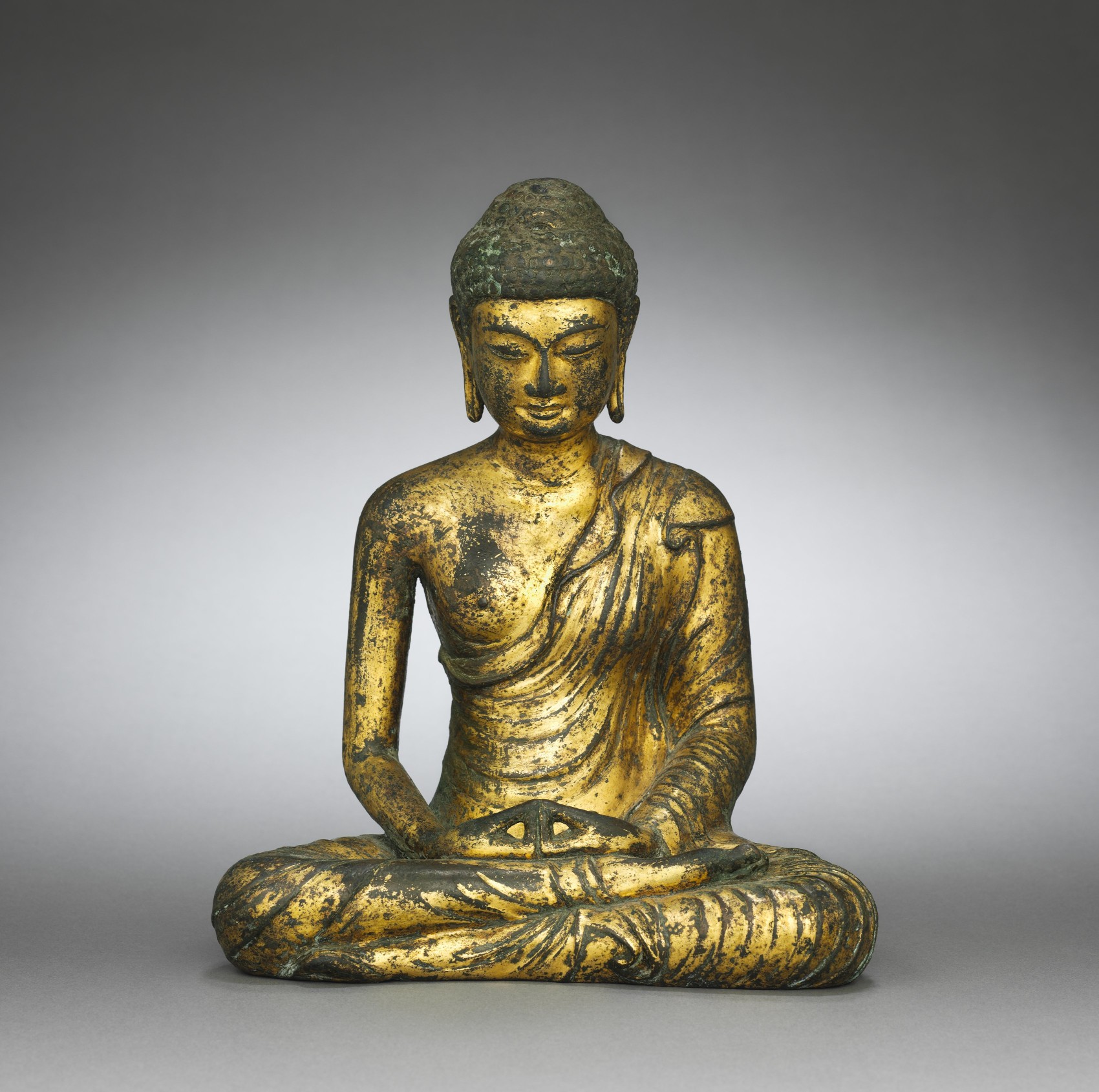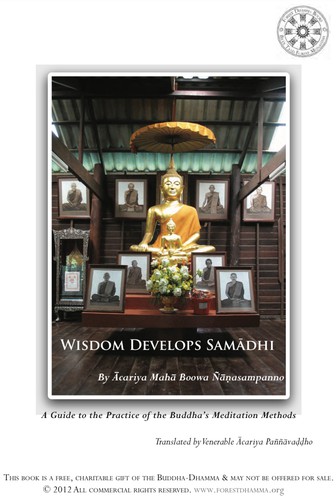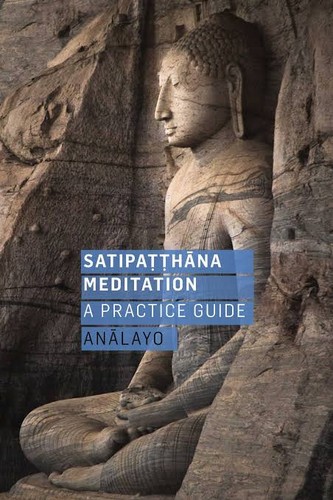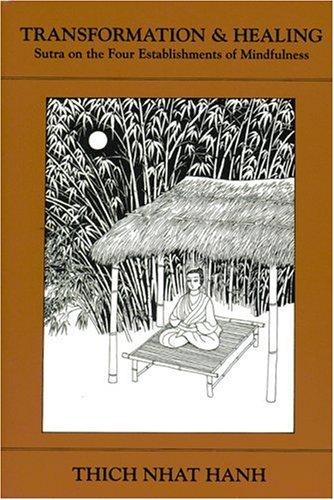Mindfulness
Subscribe to this topic via: RSS
Sammā Sati (Right Mindfulness) is the keen, dispassionate observation of the body, feelings, and mind as they actually are.

This delicate, eleventh-century bronze of Amitabha Buddha in meditation is a testament to the artist's careful attention to detail. (Image courtesy of the Cleveland Museum of Art)
Table of Contents
- Books (12)
- Canonical Works (54)
- Readings (41)
- Audio/Video (27)
- Reference Shelf (1)
- Related Topics (3)
Books (12)
Featured:
-
🥇 Best of
-
169 pages
See also:
Canonical Works (54)
Featured:
-
Perhaps the most important guide to meditation in the entire Pāli Canon.
-
For one reducing suffering like this nibbāna is said to be near.
-
⭐ Recommended
…the sign of the beautiful: frequently giving careless attention to it is the nutriment for the arising of unarisen sensual desire…
-
⭐ Recommended
One should rein in the mind thus
-
⭐ Recommended
You must carry around this bowl of oil filled to the brim between the crowd and the most beautiful girl of the land. A man with a drawn sword will be following right behind you, and wherever you spill even a little of it, right there he will fell your head.
-
Someone who had not established mindfulness of the body might well attack one of their spiritual companions and leave without saying sorry.
-
When a bhikkhu dwells thus, he overwhelms forms; forms do not overwhelm him. He overwhelms sounds; sounds do not overwhelm him…
-
… what fuels and what starves the five hindrances and the seven awakening factors
-
Restraint of the sense faculties, Kuṇḍaliya, when developed and cultivated, fulfils the three kinds of good conduct.
-
So too, all wholesome qualities are rooted in heedfulness and converge upon heedfulness
-
Mindfulness is well established in oneself: ‘In this way I’ll experience through freedom the teaching that I haven’t yet experienced, or support with wisdom in every situation the teaching I’ve already experienced.’ That’s how mindfulness is its ruler.
-
A mendicant should collect their thoughts
as a tortoise draws its limbs into its shell. -
When Ānanda visits the nuns’s quarters they tell him that their meditation is prospering to higher and higher levels. Ānanda reports the good news to the Buddha, who speaks of two ways of developing the four kinds of mindfulness meditation: directed and undirected.
-
… that wise, competent, skilful bhikkhu picks up the sign of his own mind.
-
The Buddha describes how he meditated during a three-month retreat.
-
⭐ Recommended
Bhikkhus, I will teach you the origination and the passing away of the four establishments of mindfulness. Listen…
-
What is the cause, Reverend Sāriputta, what is the reason why some sentient beings aren’t fully extinguished in the present life?
-
Five conditions that help meditation progress smoothly.
-
It’s a mendicant who, when they see a sight with their eyes, is neither happy nor sad. They remain equanimous, mindful and aware.
-
The mindful one grows better each day
but isn’t totally freed from animosity. -
The seer of the destruction of birth,
Compassionate, knows the one-way path -
When a noble disciple has wisdom, the faith, energy, mindfulness, and immersion that follow along with that become stabilized.
-
The Ganges river slants, slopes, and inclines to the east. It’s not easy to make it slant, slope, and incline to the west.
-
[He] who is released through right gnosis often dwells with a mind well-established in these four establishings of mindfulness.
-
Hey, mind! Now I will stop you
-
Nandā, see this bag of bones…
-
I wandered here and there,
jealous…
See also:
Readings (41)
Featured:
-
⭐ Recommended
It was during this fertile period—[the seventh and eighth centuries, or] “early Chan”—that the lineage myths, doctrinal innovations, and distinctive rhetorical voice of the Chan, Zen, Son, and Thien schools first emerged. Although hundreds of books and articles have appeared on the textual and doctrinal developments associated with Chan, relatively little has been written on the distinctive meditation practices, if any, of this movement. This essay emerged from an attempt to answer a seemingly straightforward question: what kinds of meditation techniques were promulgated in early Chan circles? The answer, it turned out, involved historical and philosophical forays into the notion of “mindfulness”
-
⭐ Recommended
This meaning, the author holds, might best be characterized as “lucid awareness.” He questions the common explanation of mindfulness as “bare attention,” pointing out problems that lurk behind both words in this expression.
-
… an integrative theoretical framework and systems-based neurobiological model that explains the mechanisms by which mindfulness reduces biases related to self-processing and creates a sustainable healthy mind.
-
This article argues that the word sati incorporates the meaning of “memory” and “remembrance” in much of its usage in both the suttas and the commentary, and suggests that without the memory component, the notion of mindfulness cannot be properly understood or applied, as mindfulness requires memory for its effectiveness.
-
A translation of the Chinese Version of the Kāyagatāsati Sutta (MA 81), which differs somewhat from the Pāli version of the text.
20 pages -
This article traces the changes in the understanding and instruction of mindfulness of breathing found in the suttas and commentarial tradition.
-
A collection of canonical quotations found in the Tibetan Abhidharmakośopāyikā-ṭīkā parallel to the Saṃyukta-āgama, all of which highlight the four foundations of mindfulness, their development, arising and passing away, and one’s delight in their cultivation .
16 pages -
… mindfulness and sati have [relationships] to particular conceptions of Temporality, Affect, Power, Ethics, and Selfhood.
-
Some scientific evidence for conceptualizing mindfulness as having two components: “self-regulation of attention” and an “orientation towards experience” with the latter, not the former, having the greater impact on wellbeing.
-
Throughout, mindfulness has the task of establishing and maintaining the kind of mental presence that enables a precise appraisal of the current condition of the body and the mind.
11 pages -
These results suggest a fundamental neural dissociation between two distinct forms of self-awareness that are habitually integrated but can be dissociated through attentional training: the self across time and in the present moment.
-
An overview of what sati is in the Pāli Canon and how it functions.
-
When it comes to mindfulness cultivated on its own, that is, when prominence is given to mindfulness itself during formal meditation or daily life practice, then this can be expected to result in a broad state of mind that enables an open monitoring of what is taking place.
-
The deep silence that is underneath all things is always present, always available.
-
A summary of the five occasions of liberation and how they arise through morality, concentration, and wisdom.
-
… extract the essence of leisure and fortune. To do this you must reflect upon impermanence.
-
Allowing inner awareness to be unrestricted…
See also:
Audio/Video (27)
Featured:
-
⭐ Recommended
… if you’re present, but not too present—available, but not intrusive—if you can create an environment for somebody where you’re available and interested, then this stuff will come up when it’s ready.
-

-
An interview with addiction psychiatrist and neuroscientist Judson Brewer on how mindfulness affects the brain and can be used to develop healthy habits, while overcoming unhealthy ones.
-
This dharma talks first discusses the challenge of dullness which can arise during meditation practice and then moves into how mindfulness can be practiced in daily chores and dealings in order to keep the mind alert and still.
22 min
See also:



